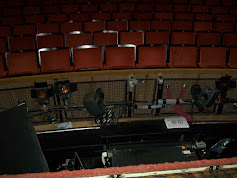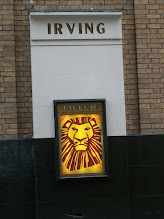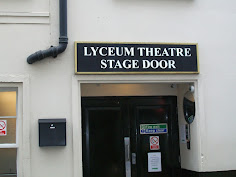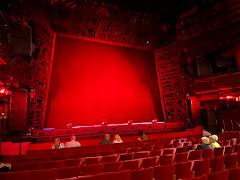The Lyceum Theatre at the Waterloo Bridge end of The Strand first opened in 1765, and for over 200 years, there has been a theatre in London’s Covent Garden called the Lyceum. It was one of the most fashionable theatres in Nineteenth-Century London, and attracted the society elite.
The current theatre is an amalgamation of styles and eras. The ‘English Opera House’, as the Lyceum was then known, burnt down in 1830 and construction of the new ‘Theatre Royal Lyceum & English Opera House’ began in 1834. The only part of the original building left is the main portico pillar entrance, which originally was the side of the theatre.
It is this part of the theatre that has the canonical link, as in ‘The Sign of Four’, a mysterious note received by Holmes’ client, Mary Morstan, directs her to “Be at the third pillar from the left outside the Lyceum Theatre tonight…” She turns up with Holmes and Watson as chaperones, and all three are whisked off by carriage at a “furious pace through the foggy streets”. In fact the Lyceum Theatre columns were actually used as a location in the ‘Sign of Four’ episode of the Granada ‘Sherlock Holmes’ TV series starring Jeremy Brett.
In 1894, Conan Doyle’s play ‘A Story of Waterloo’ had its London premiere here, starring Sir Henry Irving, and in 1901, following a copyright performance at the Duke of York’s Theatre in 1899, William Gillette’s ‘Sherlock Holmes’ opened here, following a US Tour.
Therefore, the invitation to a venue tour as a member of the loyalty scheme of the current owners, Ambassadors Theatre Group (ATG), was swiftly taken up. Arriving a few minutes early, I was directed to wait outside, doing so by the third pillar from the left (where else ?). Register taken, and our guide took us around the corner to the Lyceum Tavern, and a door which led to the previous thoroughfare into the venue.
Moving around the building to what is now the back, we looked at three memorial panels to people actively involved in the Lyceum’s story. The first of these was Henry Irving, the first actor ever to be knighted, who at the time that the first Sherlock Holmes stories were being written, owned the theatre. He was a tall, dark, dominant figure, and Conan Doyle’s favourite actor, with an earlier version of the ‘Sherlock Holmes’ play written by Conan Doyle being offered to him, an offer which was rescinded when he wanted to play both Holmes and Moriarty. Some even say that the figure of Holmes is partially based on Irving.
The manager of the theatre at that time was a certain Bram Stoker., who acted as Irving’s personal assistant, and is memoralised next to him. A few months after the first ‘Sherlock Holmes’ story was published, Stoker staged a new show ‘Dr Jekyll & Mr Hyde’ which opened in 1888. However, outcry over the ‘Jack the Ripper’ murders in the autumn meant the show was withdrawn in the interests of public decency. A few years later, Stoker wrote another horror classic, ‘Dracula’ (the only character to appear in more dramatic works than Holmes), with the tall, dark, dominant figure of the Count being said to also be partially based on Irving, alongside Vlad the Impaler.
The final panel was for Ellen Terry, who in 1878 she joined Irving's company as his leading lady, and for more than the next two decades she was considered the leading Shakespearean and comic actress in Britain.
Moving on round, to my excitement, we entered the theatre via the stage door.
Making our way past the desk and the call sheets up a long flight of stairs to the Ambassadors Lounge, where having discarded bags and coats, we made our way back down another staircase to the auditorium itself, and onto the front of the stage itself. The majority of the stage was roped off, and was not allowed to be photographed as it represented Disney copyright, but we were all able to take photos of the auditorium.




Whilst doing so, the guide went through some of the theatre’s more recent history. It was bought by London City Council in 1939, who had plans to demolish the building along with the Aldwych, Novello, Vaudeville and Adelphi theatres to make way for road improvements. The Theatre closed in 1939 with a landmark performance of ‘Hamlet’ starring radio Holmes, Sir John Gielgud in the title role. However, luckily, the Lyceum Theatre’s history didn’t end there, as the council’s road improvement plans collapsed.
After the war, the theatre re-opened as the ‘Lyceum Ballroom’ and welcomed many big bands and stars including The Who, Rolling Stones, Pink Floyd, Led Zeppelin, Queen and Prince, who played his first UK gig here in 1981. The Theatre was Grade II listed in 1978 to prevent further demolition plans, but went dark in 1986, reopening ten years later restored and reconverted with a £15 million refurbishment into a theatre for large-scale musicals or opera by the Apollo Leisure Group (with a suitably large orchestra pit), with a production of ‘Jesus Christ Superstar’ playing from 1996. Since 1999, the theatre has been home to Disney’s ‘The Lion King’.
Making our way via the Stalls Bar, we then moved to the Circle Bar, where two lights commemorate that the Lyceum was the first theatre in Europe to have its stage gaslit. (6th August 1817).
Moving into the Circle itself, we sat down to be given
details of the early days of the theatre, including the Henry Irving era, and
it seems likely that Holmes and Watson would have attended at least one of
Irving and Terry’s Shakespearian performances, given Holmes’ regular quoting of
the plays. We were then allowed ten minutes to explore the Circle and Boxes
(with their abysmal sight-lines, their purpose being to ‘be seen’ rather than
‘see the play’). We also had good sight of the former skylight (one of only two in London theatres - the other being in ATG's Apollo Victoria).
Returning to the Ambassadors Lounge, for a complimentary glass of Prosecco, I pondered on all that I had learnt. Being let out of the stage door, I made my way back down The Strand, passing the Savoy Theatre, where in 1893, the two act comic-operetta 'Jane Annie; Or The Good Conduct Prize' (co-written by Conan Doyle with friend, JM Barrie) ran between May and July, to limited critical success. In fact Barrie even wrote a Sherlock Holmes parody about the show's failure. I have previously attended several musicals, including 'Legally Blonde' and '9 to 5' here.
Continuing down The Strand, I reached the Adelphi Theatre, which currently plays host to ‘Back to the Future – The Musical’. It was here that Conan Doyle mounted a theatrical production of ‘The Speckled Band’, when an earlier effort, ‘The House of Temperley’ (based on ‘Rodney Stone’) was a critical disaster, and he had over five months of his sub-letting of the theatre to go. This performance with its rubber snake was more of a success. I had visited the theatre the previous October for a one night only performance and managed to get some photos of the auditorium.
I then continued down the Strand to Trafalgar Square, then up Charing Cross Road, across St. Martin’s Place and into St. Martin’s Lane and the Duke of York’s Theatre, where the copyright performance of ‘Sherlock Holmes’ had taken place. The theatre was currently hosting a production of ‘An Enemy of the People’ starring Eleventh Doctor actor, Matt Smith. The theatre was still closed, preparing for its matinee performance, but on a previous visit to see a play at the venue, I had managed to get photos of a quote from the play, which is on the wall outside the Gentleman’s toilet in the Circle Bar.
Opposite the Duke of Yorks is the London Coliseum where Conan Doyle's 'The Crown Diamond: An Evening With Sherlock Holmes' ran for twenty-eight performances between May 1921 and September 1921.This play was the same plot as the Sherlock Holmes short story 'The Mazarin Stone', and it is debated which came first, as the story was published only a few months after the play. Again I have previously attended musicals here.
Making my way back to Leicester Square Station, and passing the Wyndhams Theatre, which also has Sherlockian connections, and I hope to visit in a future Sojourn, I caught an Underground back to Morden, and then home.





























No comments:
Post a Comment